I was really excited for today’s 97 mile drive from Key Largo to Key West, because it would take us on one of the most unlikely highways in the United States: the Overseas Highway, the southernmost portion of the East Coast’s Route 1.
Built over an old 1911 autotrail that once connected Miami with Quebec, Route 1 today runs from Fort Kent, Maine, to Key West, Florida, and is the oldest highway still serving the East Coast. Below, the 0 mile marker in Maine:
Growing up in Massachusetts, this (plus the less picturesque drive to Boston) is pretty much how I’ve always thought of Route 1.
I have to say, it’s pretty surreal to think this is the same road:
But Route 1 didn’t always run all the way to Key West. In fact, when developer Henry Flagler announced he was going to build a railroad to connect Key West to the mainland for the first time, people thought he was completely nuts, and the project soon became known as Flagler’s Folly.
The skepticism was understandable. At the time, you could only reach the Keys by boat; connecting the entire stretch of islands (keys is said to come from “cayo,” the Spanish word for island), including a seven mile stretch over open water, would require an engineering miracle.
Nevertheless, Flagler, who had already helped to develop tourism along Florida’s east coast, from Daytona Beach to Miami, was determined to extend his rail line to Key West. And despite all the criticisms, a whopping $50 million budget, three major hurricanes, and seven years of construction, Flagler rode into Key West aboard his private railcar in 1912.
Flagler’s Folly was quickly redubbed The 8th Wonder of the World, and looking at old photographs of trains passing along its tracks during storms, it’s a pretty fitting description:
Sadly, much of the route was damaged during a devastating CAT5 hurricane in 1935. The Florida East Coast Railroad had already gone bankrupt at this point, and unable to repair the line, sold it to the state of the Miami, who used the infrastructure for the Overseas highway still in existence today.
We started driving from Key Largo…
…and immediately pulled over to take a picture with the giant rock lobster!
Enormous, eye-catching roadside animals are nothing new to Route 1. For example, anyone traveling south to Boston is well aware of the famous orange dinosaur at Route 1 Minigolf.
We also stopped for a picture with the enormous dolphins…
…and later on, the enormous fish. Apparently, all you have to do to get me to stop at your business is to put a giant aquatic creature on the front lawn.
At this point, we were still in the Upper Keys, some ways from the famous 7-mile bridge everyone thinks of when they picture the Keys. Still, the views were pretty amazing for Route 1: turquoise water, dotted with the occasional island. Quite a difference from the farmland of Massachusetts:
We stopped off shortly into the drive at Robbie’s in Islamorada for a pretty famous roadside attraction: feed the tarpon!
Basically, you pay $2 for a bucket of dead fish…
…and then you hang off the dock as 3-foot tarpons jump up and try to eat your hand off:
Apparently, the tradition began 18 years ago when the owners rescued an injured tarpon with a torn jaw, sewed it up and nursed it back to health, and released it back into the water. Nicknamed Scarface, it continued to return to the docks for snacks, and other tarpon followed suit.
Luckily, the few tarpon jaws I felt on my hand were rubbery and toothless. However, watch out for the pelicans (I think?), who are ruthless in trying to steal the bait. This guy tried to grab the fish out of my hand, and I was so startled, I threw the fish across the dock, smacking a woman in the face. Smooth.
We didn’t have much time to spend at Robbie’s, but we did take a walk through their bar, which is covered in one dollar bills from past guests:
Back on the road, we continued on…
…with a brief stop at Annie’s Beach, a popular public beach in Lower Matecumbe Key:
I had heard that Keys’ beaches are shallow, but I had no idea just how shallow. See that spec way in the distance of this photograph?
That’s a guy walking with his dog, and even that far out, he’s barely knee-deep:
For lunch, we stopped at Keys Fisheries, which got a ton of recommendations from Scouting NY readers for their famous lobster Reuben sandwich…
Man, I wanted to love this sandwich – and it looks great in my pictures. Maybe it was an off day, but when it came out of the kitchen, the lobster must have been 2,000 degrees. When it finally cooled down enough to be edible, the lobster was next to tasteless. I don’t know if they nuked it in a microwave or something, but whatever they did took all the flavor out of the lobster and made it really, really chewy. I can only think I got a fluke sandwich, as they’ve sold thousands of these over the years.
At the end of Marathon, we finally arrived at the world famous 7-mile bridge, stretching out seemingly forever into the horizon:
Though this portion of the highway is new, much of Flagler’s old railroad line still exists, running parallel to the new road. A good chuck is in a state of abandonment, but a stretch running to Pigeon Key has been turned into an awesome pedestrian walkway.
It really is pretty amazing to walk out onto the old road…
…where trains used to barrel down 100 years ago:
In fact, if you compare the postcard to what remains…
…it looks to be in pretty decent shape:
You may recall that a portion of the 7 mile bridge was blown up in True Lies. In fact, the production filmed on the old Flagler line so as to not interrupt traffic (you can tell the difference by the supports):
These guys were lounging around everywhere in the sun:
It kills me, but we didn’t have time to walk the entire 2.2 mile length of walkway to Pigeon Key, a small island marking the approximate midpoint of the 7 mile bridge, which has a number of historic buildings. Note the portion of the Flagler road removed for passage by larger boats.
As we continued on, I noticed how the state of abandonment immediately increased on the Flagler track after the pedestrian walkway ended. Here, an entire tree grows…
…while other sections are missing rails and are in pretty sorry shape.
Though we didn’t stop, I was pleased to suddenly realize we were driving through Bahia Honda Key. I just finished reading an excellent book on the golden age of piracy called The Republic Of Pirates, and a pretty great pirate battle once took place there. If you’re looking for some summer reading and have ever wondered what real piracy was like, I highly recommend it:
We found the coolest view of the abandoned train line from Spanish Harbor Key:
We pulled over to the side of the road and made our way toward the water, passing this long-abandoned structure:
I’d love to know what this was originally used for – maybe a store of some kind? Any clues are long since gone:
An ancient pipe runs alongside it:
We found a set of stairs hidden in the foliage, leading up to where the Flagler line once connected to the key:
And there was the bridge – or what remained of it:
There’s no fence or anything at the top – just a straight drop into very shallow water:
Beyond is the bridge…
…and it’s really amazing what years of abandonment have done to it, creating an almost jagged, rippled effect in the pavement:
As we made the final drive to Key West, we turned off at Big Pine Key to see if we might come across any Key Deer, an endangered species of miniature white-tailed deer native only to the Keys. It only took about two minutes of driving before we came across one…
…and then another! The National Key Deer Refuge was created to help foster population growth, which currently numbers between 300-800.
Shortly after, we arrived in Key West!
-SCOUT
PS – I’ve printed this picture twice now. Here it is one more time. Question: did you notice the man in the picture? Isn’t that really creepy??
PPS – At some point, we drove by the Turtle Hospital without realizing it. Dammit – have to hit it on the way back.



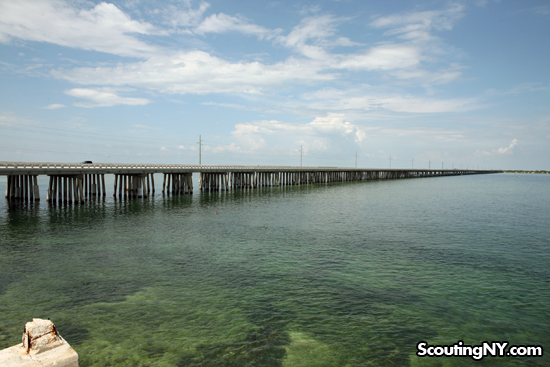



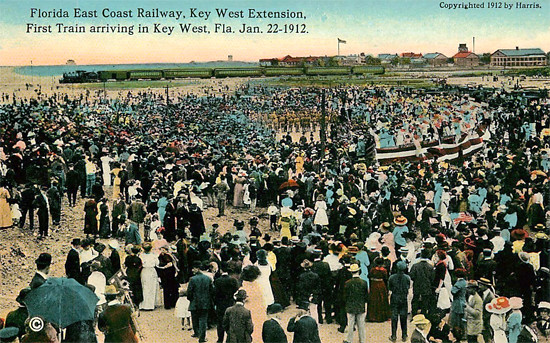

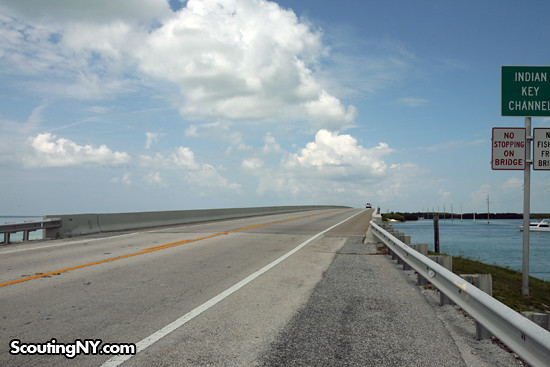


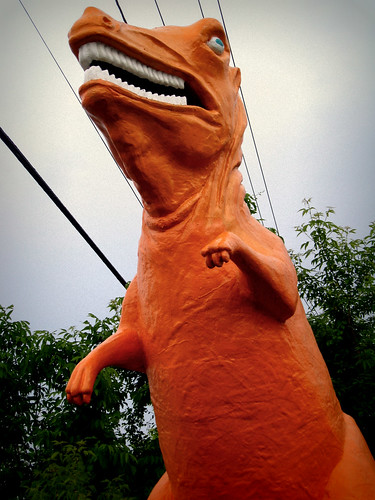

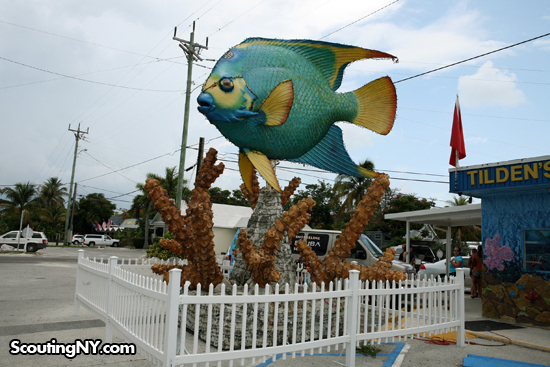

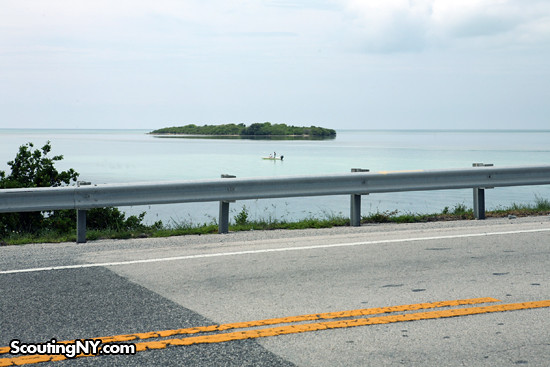

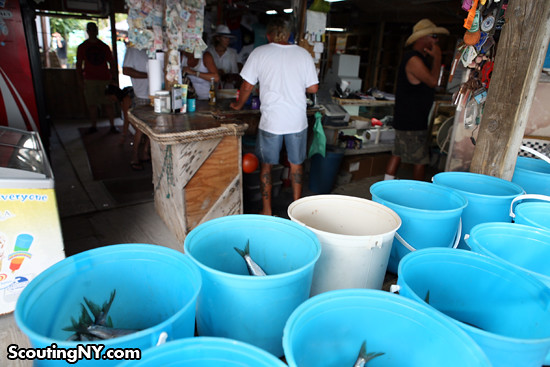

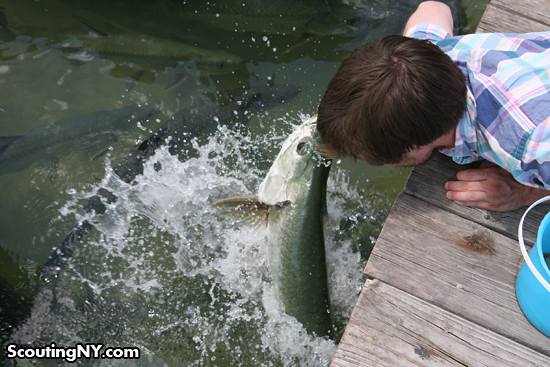

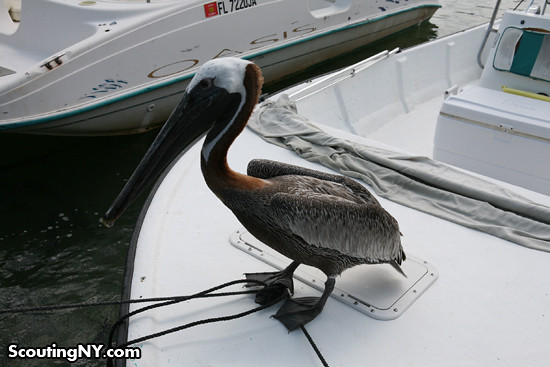
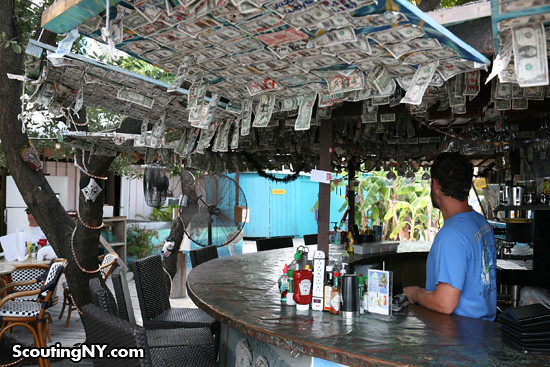





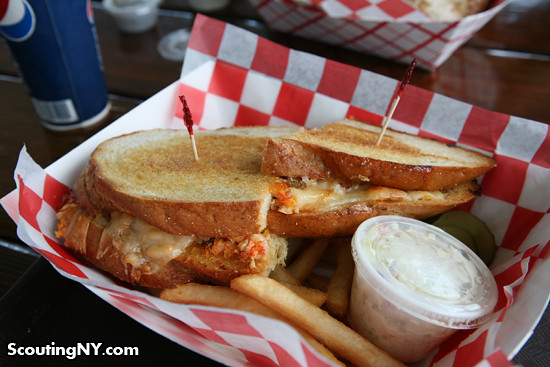
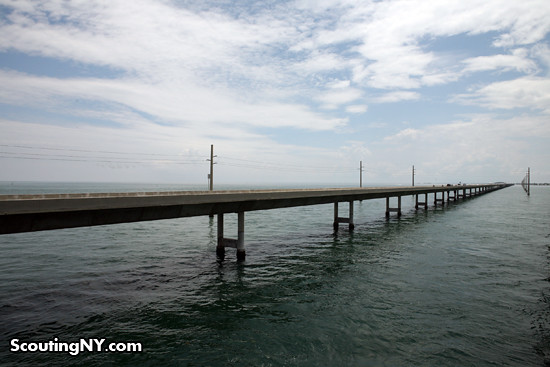
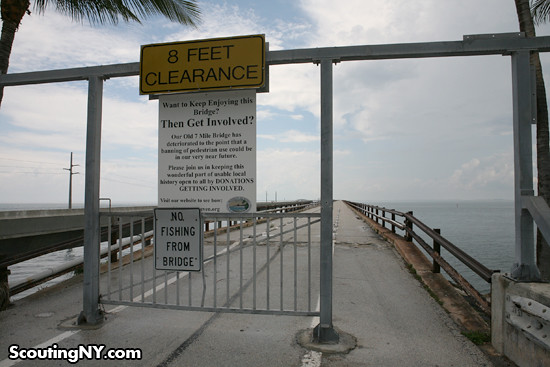

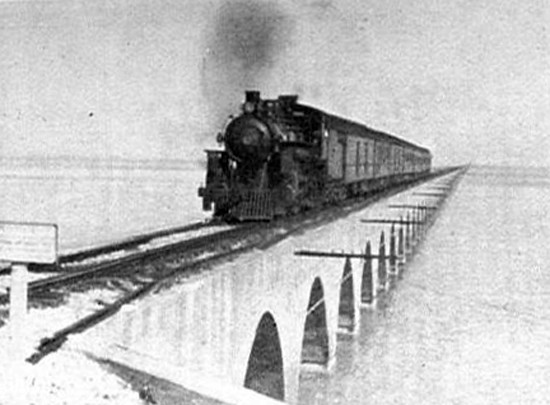
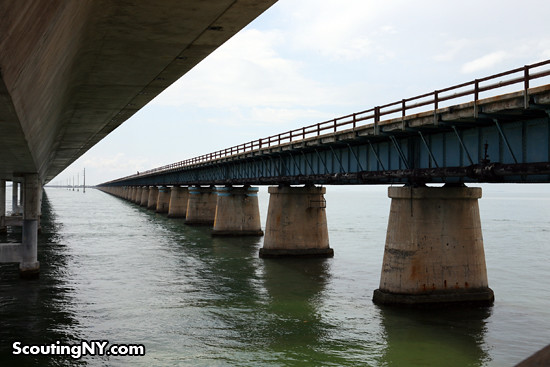
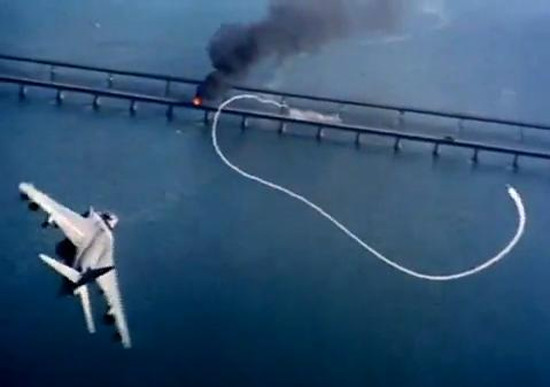
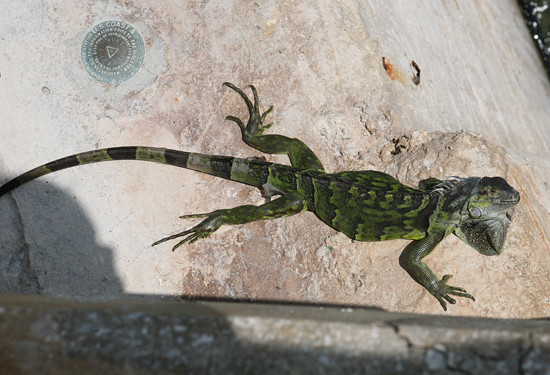
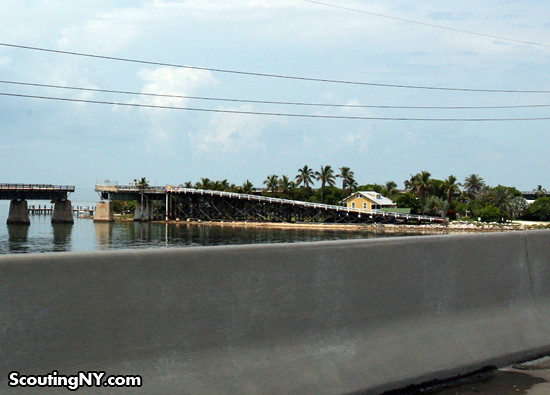
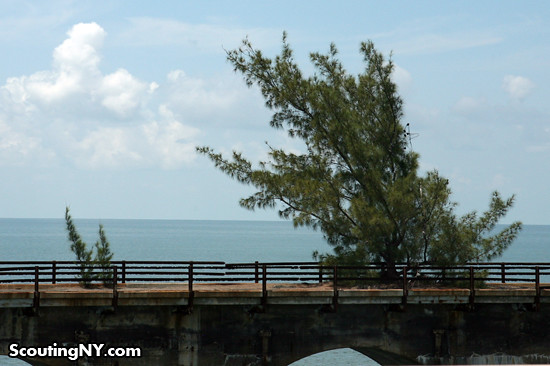





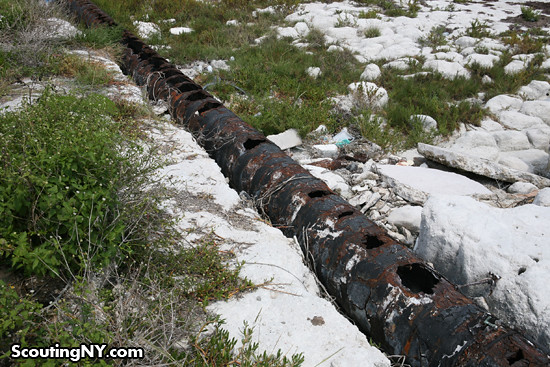





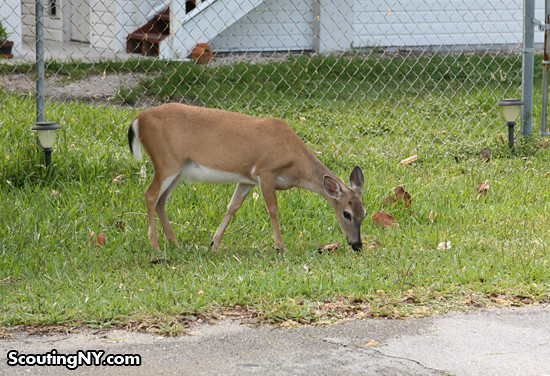


Great job with the advance scouting party. Great to see the pix of the Key West Extension. As you mentioned it was quite the engineering feat. Of course it was a different era. Can you imagine the EPA impact statement if that were tried today? Have fun in the Conch Republic.
You missed one treat. I drove the old bridges (in 1979, I think) while the new bridges were still under construction. They were absolutely terrifying. You’d basically be flying along at 65-70mph and you’d hear this high-pitched whine growing louder and louder. And you’d see a tractor-trailer (wheels humming against the curb because the road was so narrow), barreling toward you in the rear view mirror. Then there’d be a brief moment of quiet as they switched to the wrong side of the road to pass you — then the driver’s side tires screaming against that curb. Very disconcerting. 🙂
Ahoy, Scout
Welcome to the Conch Republic! I StumbledUpon your blog the other day, just in time for your road trip to Key West. We live on a boat currently anchored off Wisteria Island after spending two months in Marathon for a major refit. Somehow, we missed the Turtle Hospital, too. We’re headed the other way now, so I’m looking forward to your report.
I appreciate your sense of humor. Why doesn’t anyone stop you from getting some of those shots? Anyway, keep it up.
Fair winds,
Ean Behr
s/v more JOY everywhere
Nick, great post! I’ve been to Florida (and even location scouted there for Paramount Pictures), but not that far south. You’ve inspired me to move this up higher in my list of future destinations!
When you’re in Key West take a boat/plane ride out to Fort Jefferson- Dry Tortugas National Park, it’s about 70 miles from Key West. Very historic. Also used as a prison, its most famous prisoner was Dr. Samuel Mudd, the physician who set the broken leg of John Wilkes Booth.
http://www.nps.gov/drto/historyculture/fort-jefferson.htm
Check out Big Pine Key as well for the No Name Pub.
Scout,
cayo is actually a cay, per the OED: “A low insular bank of sand, mud, rock, coral, etc.; a sandbank; a range of low-lying reefs or rocks; orig. applied to such islets around the coast and islands of Spanish America.” The word for island in Spanish is isla, s pronounced. Great post, keep it up!
Hunter
Check out the Fort East Martello Museum featuring Robert the Doll and other crazy bits of Key West history. Make sure to check out the courtyard and inner building when you’re there. The museum wound up being an unexpected highlight of my wonderful trip to the Conch Republic. Have fun!
http://www.kwahs.com/martello.htm
I have to laugh, b/c I grew up in Massachusetts, too, and thought that the best part of Route 1 was Saugus, not the boring part in Dedham where I lived. I dreamt of driving Route 1 from Fort Kent to Key West, but with all the rerouting I couldn’t even make it through Providence without getting turned around.
So glad you were able to take time to explore those bridges! We’ve been to KW twice and both times had to get to or from in a fast way, so we didn’t get to dawdle. Thanks for bringing us along!
Just finished reading your last 3 posts Nick and as always utterly interesting, informative, great pics and altogether better than any TV docu. Thanks Scout!
I did not know such a job existed , but now realise it has been my life long ambition sooooo lucky you
Going out on a limb and claiming that mystery structure was an old telegraph relay office and that hunk of metal was once one of the telegraph lines